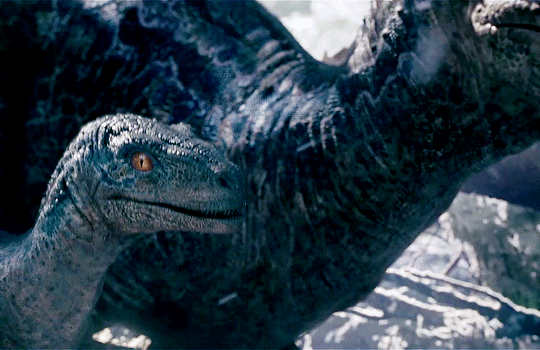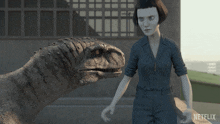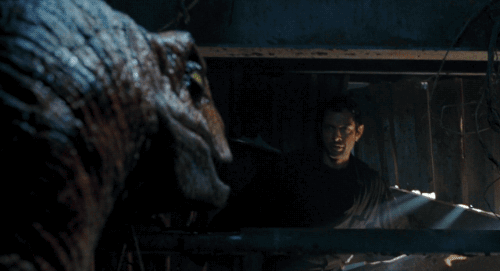Cars & Bikes

Jurassic Park’s Velociraptors: Hidden Details, Cut Scenes & Real Dinosaur Insights
May 09, 2025 6 min read
In reality, Velociraptor was a small, feathered predator—a dromaeosaurid theropod from the Late Cretaceous period that once roamed the borderlands of what is now Mongolia and China. About the size of a modern-day wolf, this dinosaur bore more resemblance to a flightless bird than the scaly movie monsters we’ve come to recognize. Its feathered body and bird-like posture gave it the look of a terrestrial hawk, with one especially lethal feature: a sickle-shaped claw on the second toe of each foot, measuring about 8 cm (3 inches). This infamous "killing claw" was likely used to slash and pierce prey, inflicting deep, fatal wounds.
Discovered in 1923, Velociraptor holds the distinction of being the first dromaeosaurid ever unearthed. Since then, over a dozen fossil skeletons have been recovered, making it the most well-known member of its family among paleontologists. Yet despite its modest size and birdlike appearance, Velociraptor has become one of the most iconic dinosaurs in popular culture—thanks entirely to Jurassic Park.
Velociraptors in the Jurassic Park Movies: From Obscurity to Icon
Before Jurassic Park roared into theaters, few people outside the scientific community had even heard of Velociraptors. But once the film premiered, these cunning predators became instant icons—an emblem of the franchise’s terrifying genius.
While the Velociraptors seen on screen are inspired by real dinosaurs, they aren’t true to the fossil record. According to the Holoscape display in Jurassic World, the film raptors appear to be a genetically engineered offshoot—a separate, fictional species created for cinematic impact. Their size, behavior, and intelligence were amplified to deliver maximum suspense, and the gamble paid off: Velociraptors have appeared in every Jurassic movie to date, playing key roles in some of the franchise’s most memorable scenes.
A Look Through the Films
Jurassic Park (1993)

The raptors made their unforgettable debut in the opening scene, instantly establishing their threat level. Later, they break free from their paddock and become the primary danger stalking the remaining humans on Isla Nublar. Their intelligence is on full display, especially when one outsmarts game warden Robert Muldoon—a moment forever etched in fans’ memories.
The Lost World: Jurassic Park (1997)
This sequel introduced a pack of raptors living in the abandoned village on Isla Sorna. These raptors were more colorful than their predecessors, a creative choice meant to differentiate males from females, though never explained on-screen. The humans must navigate a deadly maze of raptor encounters just to make it out alive.
Jurassic Park III (2001)

The third film brought more design diversity to the raptors. Males featured feathery quills and sleek skull crests, while both genders sported striking color patterns. These raptors had a clear goal: recover their stolen eggs, which led to a suspenseful game of cat-and-mouse with the stranded humans.
Jurassic World (2015)

Raptors evolved again—this time as individuals. Blue, Charlie, Delta, and Echo formed a trained pack under the watch of Owen Grady. Each had distinct colors, facial structures, and personalities. This marked a turning point: for the first time, raptors weren’t just monsters—they were characters. The film also introduced the idea of using them for military purposes, with the pack deployed to track the Indominus rex.
Jurassic World: Fallen Kingdom (2018)
Blue returned and became the first Velociraptor to carry over between films. As the last known member of her species, she was central to the plot—targeted for her DNA to create a new hybrid, the Indoraptor.

A scene set in Lockwood Manor even showcased a dramatic diorama featuring a raptor and a Dilophosaurus, adding meta-commentary on the creature’s legacy within the franchise.
Jurassic World: Dominion (2022)

Blue’s story continued, now with her own offspring, Beta. The pair are separated when Beta is captured by Biosyn operatives, kicking off a rescue subplot. Fans also spotted an Easter egg at the Amber Clave Night Market in Malta: a preserved raptor tail from the Jurassic Park III lineage—a subtle nod to the franchise’s past.
Jurassic World: Chaos Theory

In this animated expansion of the franchise, Velociraptors appear in new forms, continuing to be pivotal predators and evolving characters across timelines and story arcs.
Velociraptors in Theme Parks: From Animatronics to Real-World Screams
Velociraptors didn’t just stalk the silver screen—they leapt into the real world too, becoming a thrilling part of Universal’s theme park attractions. One of their earliest and most chilling appearances was in Jurassic Park: River Adventure. As the ride nears its climax, guests find themselves plunged into a chaos-ridden zone where the raptors have broken loose, their snarls and rustling movements adding tension to every turn.
Things got even more intense during Universal’s Halloween Horror Nights in 2002. For the first time, Islands of Adventure transformed its Jurassic Park island into JP: Extinction, a nightmare scenario where the dinosaurs had overrun the park. Hidden among the foliage were scare-actors suited up as raptors, lying in wait to terrify unsuspecting guests. It was an immersive experience that brought fans face-to-face with the terror and thrill of a raptor encounter, blurring the line between fiction and reality.
Velociraptor Appearances Throughout the Franchise
From films to animated series and beyond, here’s a chronological breakdown of key raptor appearances:
Jurassic Park
-
The Big One – Alpha female; iconic hunter
-
Randy and Kim – Other raptors, short-lived but deadly
The Lost World: Jurassic Park
-
Raptor pack residing in the abandoned Worker Village
Jurassic Park III
-
Intelligent raptor pack led by an Alpha Male and Alpha Female, notable for their evolved look and feather-like quills
Jurassic World
-
Blue – The breakout star with a strong bond to Owen Grady
-
Delta, Echo, Charlie – Each raptor had unique markings, personalities, and ultimately, tragic fates
Jurassic World: Camp Cretaceous
-
Seasons 1–5 – Blue and her original pack appear multiple times, often in high-stakes chase scenes or emotionally driven moments.
-
Later seasons introduce new raptors, many unnamed but still posing threats, especially in The Long Game, Mission Critical, and The Final Test.
-
Blue’s presence is consistent, especially in key episodes like Clever Girl, Escape from Isla Nublar, and Out of the Pack.
Jurassic World: Fallen Kingdom
-
Blue returns as an adult raptor and is revealed to be the last of her kind
-
Flashbacks or references to Blue's siblings add emotional weight
-
The idea of using Blue’s DNA for weaponized hybrids becomes central to the plot
Jurassic World: Chaos Theory
-
Season 1: Raptors resurface in “Into the Fog”
-
Season 3: Appear again in “Undercover” and “Active Pursuit,” continuing to evolve in behavior and threat level
Jurassic World: Dominion
-
Blue makes her final appearance, now raising her own offspring
-
Beta, her daughter, appears for the first (and last) time, closing the raptor chapter of the Jurassic saga
Fun Facts & Trivia: The Velociraptor Beyond the Screen
-
Philosoraptor Meme Origins
The popular internet meme Philosoraptor is a humorous nod to the Velociraptor’s sharp mind—posing deep, satirical questions as if raptors were ancient philosophers. -
Feathered Future
In the Dangerous Games comic series, the Velociraptors finally embrace their more scientifically accurate look by sporting feathers—bridging the gap between movie monster and real-life dino-bird. -
Who’s Actually Taken One Down?
Very few characters across the franchise have managed to kill a Velociraptor. Among them: Kelly and Oscar (film), Muldoon and Dr. Grant (in the novels), the T. rex, the Indominus rex, and a handful of unseen InGen Security troopers. Oh—and of course, many unnamed video game characters. -
The Unused Epic Ending
An early script draft of Jurassic Park III featured a jaw-dropping twist: Dr. Grant using the raptor resonation chamber to summon a pack of 20 Velociraptors. They arrive, tear apart the Spinosaurus, and almost turn on the humans—until one raptor gets distracted by a fresh Spino feast. That scene, however, never made it to film. -
Geographical Fiction
While the movies place Velociraptor fossils in North America, real-life remains have only ever been discovered in Asia, specifically in Mongolia and China. -
Wait, That Sound...
Believe it or not, the iconic raptor "bark" was actually sourced from the mating sounds of tortoises. That unsettling, primal screech? Straight from nature’s most unexpected audio file. -
Raptor Roots: Utahraptor or Deinonychus?
There’s long been confusion around the movie raptor’s origins. While often linked to Deinonychus per Crichton’s writing, many fans believe their large size and appearance more closely resemble Utahraptor—a real dromaeosaur discovered after Jurassic Park began filming. -
Raptor DNA in Hybrids
Velociraptor DNA plays a crucial role in Dr. Henry Wu’s most dangerous creations: the Indominus rex, Indoraptor, and the Scorpios rex. Their intelligence, agility, and cunning? All thanks to a raptor’s genetic legacy. -
Blue’s Connection to JP3 Raptors
Blue from Jurassic World shares striking similarities with the Jurassic Park III Velociraptors—both feature a signature stripe down their back and demonstrate exceptional intelligence and emotional depth.
Whether you’re a hardcore Jurassic Park fan or just fascinated by the legacy of the Velociraptor, there’s no denying their place as cinematic icons and prehistoric legends. Want to bring home the thrill of the hunt? Head over to our website now and check out our jaw-dropping collection of Jurassic Park action figures and statues—with deals up to 40% off! Don’t miss your chance to own a piece of dinosaur history.
Subscribe
Sign up to get the latest on sales, new releases and more …


